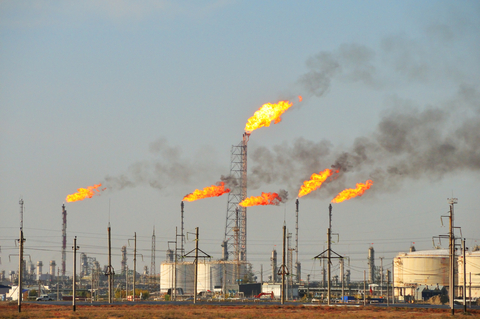
Flare Gas Reduction: Graforce a Winner at Petronas Race2Decarbonise for Groundbreaking Solution
Published by Todd Bush on March 29, 2023
BERLIN--(BUSINESS WIRE)--Out of more than 500 global solutions, Graforce was recognized at the Petronas Race2Decarbonise with its methane electrolysis technology (plasmalysis) in the category “Gas Flaring Reduction or Elimination.” The competition is aimed at accelerating the development of low-carbon solutions and reducing greenhouse gas emissions.

flare gas
>> In Other News: Gutter Capital Raises $25M to Build Companies of Consequence
Gas flaring results in more than 400 million tons of CO2 emissions every year. Thousands of gas flares at production sites around the globe burn approximately 150 billion cubic meters of natural gas each year, thus wasting a valuable resource. Plasmalysis, on the other hand, converts methane and other hydrocarbons previously vented or flared into clean hydrogen and solid carbon, thus generating climate-neutral energy.
Using hydrogen, a clean, sustainable energy source, can reduce greenhouse gas emissions and thereby mitigate climate change. Graforce is the world’s first company to offer a market-ready technology to decarbonize flare gas production and dramatically reduce emissions. Since the proprietary process doesn’t produce any CO2, this technology is also the first alternative to carbon capture and storage.
“Europe accounts for only 2 percent of global routine gas flaring, but the European Union is considering regulation to end routine flaring and venting,” said Dr. Jens Hanke, CTO of Graforce. “Being recognized in this prestigious competition is proof that flare gas plasmalysis is an excellent solution in line with methane emission regulation. Moreover, the EU can achieve its decarbonization targets if flare/landfill gas, LNG, LPG or natural gas are no longer burned, but converted into hydrogen and solid carbon powered with green electricity in our hydrogen plants.”
In the modular plasmalysis plants, a high-frequency plasma field generated by renewable electricity splits hydrocarbons, such as methane, into their molecular components: hydrogen and solid carbon. Compared to water electrolysis, plasmalysis requires only one-fifth the electrical energy to produce the same amount of hydrogen.
About Graforce
Graforce is a German hydrogen technology company. Their power-to-X plants produce carbon dioxide free or carbon dioxide negative hydrogen and synthetic feedstocks – with highest efficiency and lower infrastructure costs in the multi-megawatt range. Thus, Graforce decarbonizes fossil energies, industries and the heat, transport and building sectors. Graforce is currently in the process of expanding its financial and strategic partnerships to quickly scale its hydrogen technology worldwide.
Subscribe to the newsletter
Daily decarbonization data and news delivered to your inbox
Follow the money flow of climate, technology, and energy investments to uncover new opportunities and jobs.
Latest issues
-
The Three-Continent Move That Redefines SAF
Wishing everyone a restful holiday season.🎄🎅🎁 Inside this Issue ✈️ Cathay Goes Global With SAF in Three-Continent Fuel Deal 🧪 Proton Ventures Partners With Barents Blue For Realization Of The Bar...
-
Can One Truck Fix Hydrogen’s Biggest Problem?
Inside This Issue 🚛 Alberta's Shared Truck Model Could Crack Hydrogen Adoption ✈️ ZeroAvia Completes Financing Round 🌾 Frontier And NULIFE Scale New Biowaste Carbon Removal Approach 🔥 WAGABOX® Of ...
-
North America’s Carbon Removal Year in Review: Winners, Losers, Surprises
Inside This Issue 🌎 North America's Carbon Removal Year in Review: The Deals, Policies, and Milestones That Shaped 2025 🚢 Hapag-Lloyd And North Sea Container Line Win ZEMBA Second E-Fuel Tender 🪨 ...
Company Announcements
-
ClimeFi Announces New 85,000 Tonne Procurement Round
In its latest procurement round, ClimeFi has enabled more than US$18m in durable carbon removal purchases across eight removal pathways: Biochar, Bioenergy with Carbon Capture and Storage (BECCS), ...
-
Vallourec, a world leader in premium seamless tubular solutions, and Geostock, a global specialist in underground storage of energy, have signed a Memorandum of Understanding (MoU) to strengthen th...
-
CMA CGM, DHL Step Up Ocean Freight Decarbonization with Biofuel Deal
DHL Global Forwarding and shipping group CMA CGM have agreed to jointly use 8,990 metric tons of second-generation biofuel to reduce emissions from ocean freight. The initiative is expected to cut...
-
Next-Generation Gas Turbine Control System For Thermal Power Plants Completes Functional Testing
Integration of Mitsubishi Power's control technology with Mitsubishi Electric's high-speed data processing technology Supports rapid load adjustments and diverse fuels including hydrogen Tokyo, ...